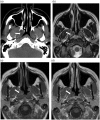Pharyngeal amyloidomas: Variable appearance on imaging
- PMID: 28627988
- PMCID: PMC5480801
- DOI: 10.1177/1971400917695318
Pharyngeal amyloidomas: Variable appearance on imaging
Abstract
Amyloidomas are rare tumor-like depositions of abnormally folded, insoluble proteins that may be seen in the setting of systemic amyloidosis or as isolated tumoral deposits. Focal, isolated amyloidomas carry an excellent prognosis whereas systemic amyloidoses do not. The ability to identify or suggest amyloidoma on imaging studies may help direct laboratory testing and eventual diagnosis. Amyloidomas involving the head and neck have been variably described from homogeneously T2 hypointense to iso-slightly hyperintense relative to skeletal muscle. Herein we present two patients with pharyngeal submucosal amyloidomas of differing sizes and imaging characteristics to emphasize their potential widely variable imaging appearance and broaden our knowledge of these rare lesions.
Keywords: Amyloidomas; amyloidoses; amyloidosis; head and neck; plasmacytoma.
Figures


References
-
- Penner C, Muller S. Head and neck amyloidosis: A clinicopathologic study of 15 cases. Oral Oncol 2006; 42: 421–429. - PubMed
-
- Falk R, Comenzo R, Skinner M. The systemic amyloidoses. New Engl J Med 1997; 337: 898–909. - PubMed
-
- Bardin RL, Barnes CE, Stanton CA, et al. Soft tissue amyloidoma of the extremities: A case report and review of the literature. Arch Pathol Lab Med 2004; 128: 1270–1273. - PubMed
Publication types
MeSH terms
Substances
LinkOut - more resources
Full Text Sources
Other Literature Sources
Medical

